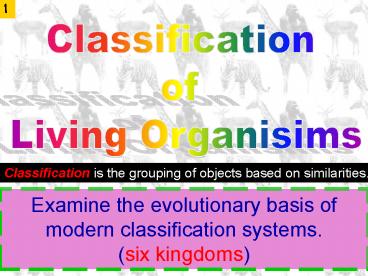Classification - PowerPoint PPT Presentation
1 / 29
Title:
Classification
Description:
1 Classification is the grouping of objects based on similarities. Examine the evolutionary basis of modern classification systems. (six kingdoms) – PowerPoint PPT presentation
Number of Views:75
Avg rating:3.0/5.0
Title: Classification
1
1
Classification of Living Organisims
Classification is the grouping of objects based
on similarities.
Examine the evolutionary basis of modern
classification systems. (six kingdoms)
2
Classification
2
- Classification is an important process in
understanding how organisms are related and how
they are different. - Taxonomy is the branch of biology that studies
the grouping and naming of organisms.
3
Aristotle
3
- Ancient Greece
- Aristotle (384 BC to 322 BC) was the first to use
a classification system. - classified living things into two categories
plants and animals. - Plants -shrubs, herbs, or trees.
- Animals -according to where they lived.
His classification system was based on structural
differences that were seen.
4
Carolus Linnaeus (1707-1778)
4
- Swedish Botantist
Considered to be the Father of modern Taxonomy
based his classification on characteristics of
organisms that were similar.
Developed the two word system used to identify
species binomial nomenclature.
5
5
- Linnaeus used Latin for the Names of his
categories, because this was the language of
educated people and not likely to change whereas
an everyday language is likely to change.
Clip on next slide
6
(No Transcript)
7
Binomial nomenclature
6
- Because scientists speak many different languages
and common names for organisms may vary from
place to place, a universal system for naming
organisms is used. - The scientific name of an organism is based on a
two-word system called binomial nomenclature.
8
7
Quercus alba is the name for white oak (alba is
Latin for white) Quercus rubra is the name
for the red oak (rubra is Latin for red)
Micropterus salmoides is the name for a
largemouth bass
9
Binomial nomenclature
8
- The two words, genus and species, are always
italicized (or underlined). - The first word in a scientific name, genus, is
always capitalized and the second word, species,
is never capitalized. - For example the scientific name of the largemouth
bass would be Micropterus salmoides (or
Micropterus salmoides).
10
9
- In addition to (1) appearance and (2)behavior,
(3) molecular structure (e.g., DNA) and(4)
evolutionary relationships are also considered
when classifying organisms.
- Organisms that share more similarities are more
closely related and are grouped together.
11
10
Eight levels of classification
Domain
Least alike
Most alike
12
GROUP NAME ORGANISM ORGANISM ORGANISM ORGANISM ORGANISM
GROUP NAME HUMAN CHIMPANZEE HOUSE CAT LION HOUSEFLY
KINGDOM Animalia Animalia Animalia Animalia Animalia
PHYLUM Chordate Chordate Chordate Chordate Arthropoda
CLASS Mammal Mammal Mammal Mammal Insect
ORDER Primates Primates Carnivora Carnivora Diptera
FAMILY Hominidae Pongidae Felidae Felidae Muscidae
GENUS Homo Pan Felis Felis Musca
SPECIES sapiens troglodytes domestica leo domestica
Scientific Name Homo sapiens Pan troglodytes Felis domestica Felis leo Musca domestica
11
13
Example Human Classification
12
Domain Eukarya Kingdom Animalia Phylum
Chordata Class Mammalia Order Primate
Family Hominidae Genus Homo Specific
sapiens
How would you write the scientific name?
a. homo Sapiens b. Homo sapiens c. Homo Sapiens
14
14
15
KINGDOMS OF LIFE
15
16
16
Six Kingdoms of Life
Plantae
Protista
Eu- Bacteria
Animalia
Archae - Bacteria
Fungi
17
17
Three Domains and Six Kingdoms Three
Domains Bacteria- Unicellular and prokaryotic.
Autotrophic and Heterotrophic. Cell walls have
peptidoglycan. Kingdoms Eubacteria Archaea-
Unicellular and prokaryotic. Cell walls do not
have peptidoglycan. Kingdoms Archaebacteria Euka
rya- Eukaryotic Kingdoms Protista, Plantae,
Fungi, Animalia.
18
18
Bacteria
Protista
Fungi
- Eubacteria Archaebacteria
- Prokaryotes
- Unicellular
- Heterotropic and autotrophic
- Eukaryotes
- Unicellular or multicellular
- Heterotrophic
- Eukaryotes
- Unicellular and multicellular
- Heterotropic and autotrophic
19
19
Plantae
Animalia
- Eukaryotes
- Multicellular
- Autotrophic
- Eukaryotes
- Multicellular
- Heterotrophic
20
6 Kingdoms of Life
20
Clip on next slide
21
(No Transcript)
22
21
Evolutionary relationship between the kingdoms.
Clip on next slide
23
22
- A tool to identify organisms is called a
dichotomous key. - It is made from pairs of contrasting
characteristics (e.g., has wings/does not have
wings).
24
EOCT ALERT!!!!
23
- A multicellular organism that obtains its food by
absorbing nutrients from the soil belongs to the
kingdom - A Animalia
- B Fungi
- C Plantae
- D Protista
25
24
- The study of animals is known as
- A botany
- B ecology
- C taxonomy
- D zoology
26
25
- In 1988, the tiger swallowtail, Papilio glaucus,
was proclaimed Georgias state butterfly. The
tiger swallowtail shares the most characteristics
with members of which taxonomic level? - A class
- B family
- C order
- D phylum
27
26
One main difference between members of the
Kingdoms Plantae and Animalia is the ability
to A obtain energy B reproduce C move D exchange
gases
28
(No Transcript)
29
(No Transcript)































